Abstract
Optimisation at B3LYP/6-311G(d,p) was used in a DFT study of the characteristics of 2-methylthio(methylsulfonyl)-triazoloquinazolines (1, 2). The design-critical role of intramolecular hydrogen bonding in stabilising both structures is emphasised. The stability of a crystal is a consequence of interactions between its molecules. According to the global index, 2-methylthio-triazoloquinazoline (1) is more electrophilic and reactive, while 2-methylsulfonyl-triazoloquinazoline (2) is more electrophilic and less reactive. Electrophilic, nucleophilic, and radicalophilic sites, polarizable atoms, and charge distributions are all identified by local descriptors. Consistent with crystal structures, negative potentials imply 1 and 2 hydrogen bond acceptors, whereas positive potentials indicate donor capabilities. Antioxidant activity may be enabled via radical stabilisation, as suggested by radicalophilic features such as hydrogen atom donors, resonance, and antioxidants. H7, H8, and H9 atoms in triazoloquinazolines 1 and 2 have been hypothesised to contribute to the compounds’ antioxidant activity through HAT, SPLET, and SET-PT mechanisms. Calculations provide insights into stability, reactivity, electrostatic profiles, radical stabilization ability, toxicity risks. Radical stabilizing ability, reactive site hierarchies suggest possible antioxidant mechanisms. ADMET profiles identify challenges impacting candidate suitability.
1. Introduction
The biologically crucial platforms of triazoloquinazolines are associated with a wide range of pharmacological activities. These heterocyclic systems have been credited with a variety of beneficial pharmacological effects, including those with anti-inflammatory, antihistaminic, antihypertensive, anticancer, antimicrobial, and antiviral properties [1,2,3,4,5]. Because of the wide variety of pharmacological effects produced by these heterocyclic systems, researchers in medicinal chemistry have developed multiple chemical strategies for discovering and building many potent and efficient derivatives. Triazoloquinazoline system has demonstrated a wide variety of promising activities against a wide diversity of targets. Several pharmacological analyses and structure-activity relationship investigations have gradually shown a connection between the unique structural properties of the triazoloquinazoline system and its pharmacological functions [2]. The majority of triazoloquinazoline analogues have an intrinsic lactam/thiolactam group, and the chemical modification of this functional group allowed access to a wide range of heterocyclic molecules [6,7,8,9,10,11]. The triazoloquinazoline system combined the chemical properties of quinazoline and triazole, making it appropriate for a variety of nucleophilic and electrophilic substitution processes on the triazole ring or the quinazoline part. New effective antioxidants have been constructed and developed owing to the useful insights gained from the structural chemistry features of triazoloquinazolines and their potential for chemical modifications [12]. Thus, we concentrate on the chemistry of triazoloquinazolines, specifically those dealing with their crystal structures. In this paper, we describe the DFT, and Hirshfeld analyses of the crystalized triazoloquinazoline structures 1 and 2. Investigation the radicalophilic properties of 1 and 2 suggests that antioxidant activity could be achieved by radical stabilisation.
2. Materials and Methods
2.1. Single-Crystal X-ray Diffraction
Previous work by our group [3,7,8,10] described the chemical properties and X-ray structure of triazoloquinazolines 1 and 2. Here, their crystalline structures were investigated in more detail by applying the SCXRD findings. Structure determination details and crystallographic information are summarised in Section 3.1. The ORTEP3 programmes were used to generate the geometry and identify the weak interactions [13]. Visualisation and molecular graphics were performed using DIAMOND 5, [14]. Section 3.2 list various bond lengths and bond angles for compounds 1 and 2, respectively.
2.2. Computational Methods
In this study, the DFT calculations were initiated with experimental single-crystal X-ray data to establish the initial geometries [8,10]. Geometry optimizations of various isolated monomer and dimer models were then performed in the gas phase using the Gaussian 09, Rev D.01 software package [15]. The GaussView 6.0 program [16] was utilized for visualizing, analyzing, modifying, and exporting the data. For the calculations, the B3LYP/6-311G(d,p) functional was employed [17]. The most recent functional developed by Head-Gordon and collaborators, known as wB97XD, has been employed in this study. This functional incorporates a variation of Grimme’s D2 dispersion model and also integrates long-range corrections [18]. It has been determined that wB97X-D is the most suitable DFT functional for accurately representing hydrogen bonding interactions [19]. Computational methods were employed to determine the binding energies for dimers and larger assemblies of compounds 1 and 2. Frequency calculations for dimer pairs of both compounds were carried out using the Gaussian 09, Rev D.01 software package [15] at the B3LYP/6-311G(d,p) level of theory. For larger structures, such as tetramers and trimers of compounds 1 and 2, geometries were obtained either through gradient optimization in vacuum or by extracting from experimental data. Binding energies, as well as average binding energies per ion, were corrected for the basis set superposition error (BSSE) [20,21,22] to ensure more accurate results.
2.2.1. Hirshsfeld Surface Analysis
Hirshfeld Surface (HS) analysis was performed on the crystal structures of the triazoloquinazolines 1 and 2 to visualize the intermolecular interactions. The analysis was conducted using crystal explorer 21 software in combination with Olex2-1.5-alpha. The crystallographic information file (cif) of the compounds served as input for the crystal explorer program. The HS analysis involved examining the spatial arrangement of atoms in relation to the hirshfeld surface, which is determined based on the relative van der waals radii. The di (inside) and de (outside) values represent the distances from the nuclei to the hirshfeld surface. The HS map, generated based on dnorm, shows a white surface where the distances match the sum of van der waals radii. Red and blue colors indicate distances shorter or longer than the van der waals radii. This analysis aids in identifying and visualizing the nature and strength of intermolecular interactions, including hydrogen bonding, van der waals contacts, and other non-covalent interactions, within the crystal lattice of the compound under investigation.
2.2.2. Density Functional Theory (DFT)
DFT calculations were performed on the compounds 1 and 2 using the Gaussian 09 software. The GaussView program was used to visualize and modify these initial structures. The output files were analyzed using various software including VMD, Multifwn, CrystalExplorer, AIM-All, and Olex2 [13,23,24,25]. The geometry of the both compounds were optimized at the B3LYP/6-311G(d,p) level of theory, with reference to the experimental X-ray data. Frontier molecular orbital (FMO) and molecular electrostatic potential (MEP) calculations were performed at the DFT/B3LYP/6-311G(d,p) level of theory. Hirshfeld surface analysis and quantum theory of atoms in molecules (QTAIM) analysis were used to study the non-covalent interactions in the crystal structure. Global reactivity parameters, such as electrophilicity index, electron affinity, ionization potential, electronegativity, softness, hardness and chemical potential, were calculated based on the energies of the highest occupied and lowest unoccupied molecular orbitals (HOMO and LUMO). Local reactivity descriptors including Fukui functions and local softness were determined to identify the most reactive sites of the molecule. In our previous study, DFT was conducted as a method for studying antioxidant activity [26].
3. Results and Discussion
3.1. Exploration of the Crystal Structure of Investigated Targets
Triazoloquinazolines 1 and 2 (Scheme 1) were previously synthesized and fully described [3,7]. The structures of C10H8N4OS (1) and C10H8N4O3S (2) were ascertained by means of SCXRD. Relevant crystallographic data and refinement information are listed in Table 1. Experimental geometrical parameters along with related optimized results are summarized in Table 2 and Table 3. As anticipated, the calculated values of the bond lengths and angles slightly divert from those observed experimentally. Such discrepancy occurs due to the crystal packing which modifies the parameters of the relaxed molecules. The DIAMOND plots of the asymmetric units with the atom numbering scheme are shown in Figure 1.

Scheme 1.
Synthetic routes for triazoloquinazolines 1 and 2.

Table 1.
Crystal data and details of the structure determination [8,10].

Table 2.
Comparison of experimental (X-ray) and theoretical [B3LYP/6-311G(d,p)] lengths (Å) for compounds 1 and 2.

Table 3.
Comparative analysis of experimental (X-ray) and theoretical [B3LYP/6-311G(d,p)] angles (in degrees) for compounds 1 and 2.
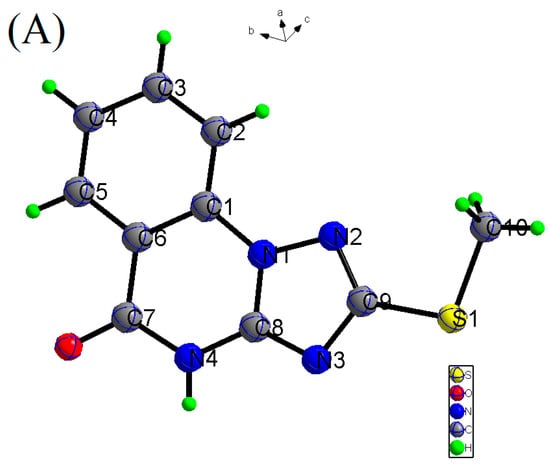
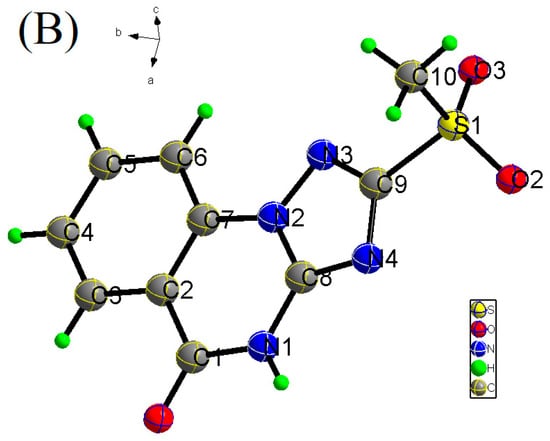
Figure 1.
DIAMOND plots of the asymmetric units for 2-methylthio-triazoloquinazoline (A) and 2-methylsulfonyl-triazoloquinazoline (B) with the atom numbering.
Crystal data and details of the structure determination for two compounds [8,10] are provided in Table 1. The information can be analyzed, and the aspects related to structure determination and crystal packing can be discussed.
The monoclinic crystal system is belonged to by both compounds and the P21/c space group is where 1 crystallized, while 2 crystallized in the P21 space group. The symmetry and arrangement of the crystal lattice are determined by the crystal system and space group. Information about the dimensions and angles of the unit cell is provided by the unit cell parameters (Table 1). The comparison between experimental (X-ray) and theoretical [B3LYP/6-311G(d,p)] bond lengths and angles for compounds 1 and 2 are presented in Table 2. The accuracy of the theoretical calculations can be assessed by examining the mean absolute error (MAE) and mean squared error (MSE) values. For compound 1, the calculated bond lengths show good agreement with the experimental X-ray data, with a small MAE of 0.006867 Å and an MSE of 7.17 × 10−5 Å2. This suggests that the theoretical calculations for compound 1 are reliable and accurately represent the experimental bond lengths. In comparison, the MAE and MSE values for 2 are considerably higher, with an MAE of 0.034225 Å and an MSE of 0.001719 Å2. This indicates that the theoretical calculations for 2 deviate more from the experimental X-ray data compared to 1. Although the deviations are still relatively small, they suggest that the theoretical model for compound 2 may require further refinement to better represent the experimental bond lengths.
3.2. Molecular Geometries of Compounds 1 and 2
The refined structures, together with their corresponding experimental models, can be found in Figure 2 and Table 2 and Table 3. A detailed examination of the depictions in Figure 2 reveals that, in general, the primary backbone frameworks of the computationally fine-tuned geometries align well with the structures reported through experimentation. Key computed and experimental bond lengths and bond angles are juxtaposed for both of the mentioned compounds in Table 2 and Table 3, respectively.
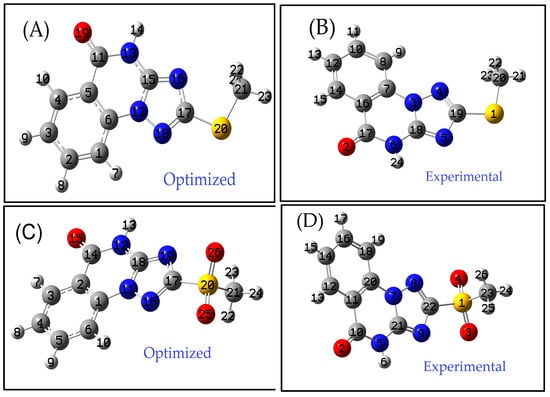
Figure 2.
Depictions of molecular structures for compounds 1 (A,B) and 2 (C,D) using the ωB97XD/6-311G(d,p) theoretical level, presenting both experimental and optimized geometries in a side-by-side comparison. Colored balls represent the atoms, with each color corresponding to a specific element: blue for nitrogen, yellow for sulfur, red for oxygen, the standard element color for carbon, and white for hydrogen.
When comparing the experimental and theoretical bond angles, compound 1 again exhibits good agreement between the calculated values and the X-ray data, with an MAE of 0.493488° and an MSE of 0.366574°2. This demonstrates that the theoretical calculations for compound 1 are reliable in terms of bond angles as well. For compound 2, the MAE and MSE values are considerably higher than those for 1, with an MAE of 1.808658° and an MSE of 5.068006°2. This indicates a greater discrepancy between the calculated bond angles and the experimental X-ray data for 2 (Table 3).
A moderately comparable pattern was detected between the obtained experimental and calculated geometries for the arrangement of four molecules of compound 1 and the dimer forms of compound 2, in which the previously mentioned bonds were also acceptably recreated. For compound 2, the H-bond connecting two monomers measured 2.74095 and 2.67213 Å across experimental and calculated geometries, respectively. The minor deviation here could be ascribed to the X-ray method’s limitations in precisely determining H atoms in a molecule, [18,19] but the primary experimental geometry was adequately reproduced by the implemented quantum chemical technique.
The dimeric configuration was refined using both with and without Grimme’s dispersion correction, and a side-by-side analysis was demonstrated in Figure 3C,D. The two closest interactions of a dimer exhibited marginally reduced distances in the structure optimized with Grimme’s dispersion correction compared to the structure refined without it. For example, in compound 2’s Grimme’s dispersion-corrected optimized structure, the C23−H25...O29 distances were determined to be 2.74095 Å, as opposed to the 2.67213 Å distances lacking Grimme’s dispersion adjustments (refer to Figure 3C,D).
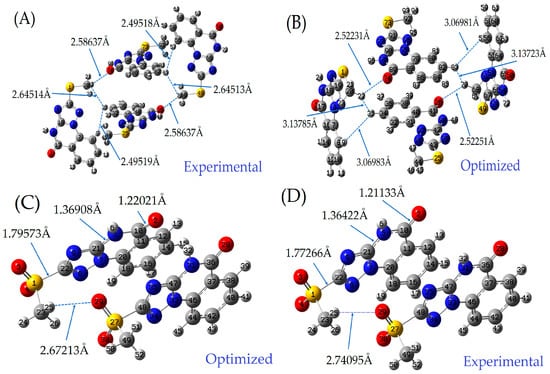
Figure 3.
Side-by-side presentation of experimental and optimized molecular structures for compounds 1 (A,B) and 2 (C,D), computed using the wB97XD/6-31G(d,p) theoretical approach. Colored balls represent the atoms, with each color corresponding to a specific element: blue for nitrogen, yellow for sulfur, red for oxygen, the standard element color for carbon, and white for hydrogen.
3.3. Intermolecular Interactions of the Compounds 1 and 2
Based on the geometrical measurements, the intermolecular interactions of both triazoloquinazolines 1 and 2 are analyzed (Table 4). In case of 1, the intermolecular interaction is found to occur through an N4–H4…N3 hydrogen bond, while in 2, the interaction is observed to take place through an N1–H1…O2 hydrogen bond. In both cases, significant hydrogen bonding is revealed by the geometrical measurements, which is considered to play a crucial role in the internal stabilization of the compounds. In triazoloquinazoline 1, the distance between the donor (N4) amino and acceptor (N3) amine atoms is measured to be 2.896 Å, with an angle of 174° (Figure 4A). Conversely, in 2, the overall distance between the donor (N1) and acceptor (O2) atoms is determined to be 3.072 Å, with an angle of 160° (Figure 4B). These measurements indicate that the hydrogen bonding in 1 is somewhat stronger than in 2, reflecting the different chemical environments provided by the amine and imino groups in 1 and the methylsulfonyl and imino groups in 2. Despite the differences in their intermolecular interactions, notable internal stabilization is exhibited by both compounds due to the presence of these hydrogen bonds. The overall properties of the compounds are influenced by these interactions, and their potential interactions with other molecules in various biological and chemical systems may be affected.

Table 4.
Geometrical measurements associated with various intermolecular and intermolecular interactions (distances in Å and angles in degrees).
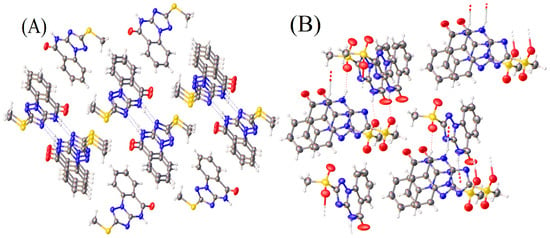
Figure 4.
Partial packing diagram: (A) Depicts compound 1, illustrating the N4–H4…N3 hydrogen bonds represented by blue dashed lines. (B) Showcases compound 2, highlighting the N1–H1…O2 interactions, denoted by red dashed lines. Both diagrams emphasize the relevant hydrogen bonding patterns within each compound.
3.4. Dimers’ Energetic and Structural Characterization Scenarios
For compound 1: Conformation A (side-to-side) has a positive ∆E(BSSE) value of 6.16 kcal/mole, indicating that it is less stable compared to other conformations. It is energetically unfavorable and unlikely to exist in this arrangement. The on-top parallel geometry of the (C10H8N4OS)1 dimer was not observed, which could likely be due to the significant nonbonded repulsion between the six-membered carbon ring faces of the two monomers during their head-on approaches. This repulsion is believed to have surpassed the corresponding attractive forces, leading to the destabilization (instability) of the said geometry. Conformation B (face-to-face) has a negative ∆E(BSSE) value of −4.08 kcal/mole, suggesting that it is more stable than conformation A. This arrangement exhibits favourable interactions between the monomers. Conformation C (tetramer arrangement) has a negative ∆E (BSSE) value of −4.96 kcal/mole, which also indicates a stable arrangement. It seems to be even more stable than conformation B, suggesting that the tetramer structure could be the most stable arrangement for compound 1 (Table 5 and Figure S3A–C).

Table 5.
Chosen energetic characteristics of compound 1 and 2 dimers, determined using the wB97XD method alongside the 6-311G(d,p) basis set.
For compound 2, conformation D (side-to-side) has a negative ∆E(BSSE) value of −17.47 kcal/mole, signifying stability and energetic favorability. This arrangement indicates robust interactions between the monomers. The on-top parallel geometry of the (C10H8N4O3S)2 dimer was identified, which could likely be attributed to the significant hydrogen bonding between the oxygen atom of the sulfonyl group in one monomer and a hydrogen atom of the methyl group in the other monomer. This attractive force is thought to have overcome the corresponding repulsive forces, resulting in the stabilization (stability) of the said geometry. Conformation E (face-to-face) exhibits a negative ∆E(BSSE) value of −3.24 kcal/mole, suggesting stability, albeit to a lesser extent than conformation D. This conformation has weaker interactions between monomers compared to the side-to-side arrangement. Conformation F (trimer arrangement) has a negative ∆E(BSSE) value of −18.64 kcal/mole, indicating that it is the most stable arrangement for compound 2. The trimer structure appears to display the strongest favorable interactions between monomers for this compound (Table 5 and Figure S3D–F).
3.5. Hirshfeld Surface Analysis
The objective of the hirshfeld surface (HS) analysis was to gain insights into the significant intermolecular interactions present in the crystalline arrangements of the compounds. The HSs, depicted in Figure 5, were mapped using dnorm. Notably, the brightest red spots on the surface corresponded to strong N1-H1...O2 classical hydrogen bonds, involving the acceptor N3 nitrogen atom of the amido group and the donor N4 nitrogen atom of an adjacent fragment. The distances between these atoms (dH-O = 3.072 Å) were found to be significantly shorter than the corresponding sum of van der waals (VdW) radii, indicating the pivotal role of these hydrogen bonds in the crystal packing [27,28]. Furthermore, the presence of π-stacking interactions in the structures was confirmed by the observation of red and blue triangle pairs on the shape-index surfaces, which can be seen as white circles in Figure 5B. The blue bumps on the surface represented convex regions, attributed to the ring carbon atoms of the molecule located within the surface. On the other hand, the bright red cavities displayed concave regions caused by the carbon atoms of the π-stacked molecule positioned outside the surface. Additionally, the relatively large green regions observed as flat patches in the curvedness mapped surfaces (Figure 5A–F) indicated the existence of Cg-Cg (π-π) inter-contacts [27,29].


Figure 5.
Hirshfeld surface analysis of compounds 1 and 2: This figure presents the hirshfeld surface analysis for (A–C) compound 1 and (D–F) compound 2. (A) dnorm visualization for compound 1, with red indicating negative values, white representing zero, and blue signifying positive values. (B) Shape index for compound 1, highlighting the presence of red and blue triangles within the black ellipse, which represent bumps and hollow regions on the shape index surface, respectively. (C) Curvedness analysis for compound 1, identifying planar (green) and curved (blue edge) regions relevant to planar stacking interactions. Similarly, compound 2 is visualized using (D) dnorm, (E) shape index, and (F) curvedness, showcasing the corresponding properties for this compound.
Distribution of the individual intermolecular interactions based on the hirshfeld surface analysis of the studied compounds 1 and 2 were provided in Figure 6. The 2D fingerprint plots (di vs. de), depicting the relevant intermolecular interactions, were shown in Figures S1 and S2. Notably, almost all contacts occurred between two chemically and crystallographically equal monomers, resulting in symmetric maps. The analysis revealed that H...H contacts made the most significant contribution to the total HS, accounting for 30.6% and 20.6% in compounds 1 and 2, respectively. The dominance of H...H contacts could be attributed to the small VdW radii of hydrogen atoms, indicating the shortest distance on the surface [26]. Furthermore, the other prominent intercontacts were CH/H...C, covering 13.9% and 10.9% of all interactions in compounds 1 and 2, respectively. The pair of narrow spikes observed around (1.4 Å + 1.1 Å) for 1 and (1.3 Å + 0.9 Å) for 2 could be attributed to close O...H/H...O interactions, constituting 11.4% and 38.0% of all interactions, respectively. Importantly, the contribution of C...C contacts, representing π...π interactions, was 3.9% in 1 and 4.0% in 2, indicating an equal stacking of both monomers. The O...C (π) contacts occupied 1.9% in 1 and 2% in 2. Additionally, the crystalline structures were maintained by C...N, H...N, and O...O contacts, although with lower contributions. Compound 2 exhibited values of 7.3% for C...N contacts, 14.9% for H...N contacts, and 10.4% for O...O contacts. On the other hand, compound 1 displayed values of 0.9% for C...N contacts, 1% for H...N contacts, and 4.1% for O...O contacts. Moreover, there were also C...S, H...S, O...S, N...S, and N...N contacts with respective contributions of 1.3%, 7%, 1.2%, 2.7%, and 0.3% in 1, and 4%, 0.1%, 0.9%, 1.4%, and 7.3% in 2 (Figures S1 and S2).
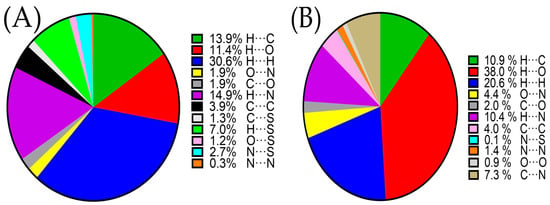
Figure 6.
Hirshfeld surface analysis illustrating intermolecular interactions: This figure depicts the distribution of specific intermolecular interactions for (A) compound 1 and (B) compound 2, as revealed through the Hirshfeld surface analysis. The visual representation of these interactions offers valuable insights into the molecular properties and behavior of both compounds, contributing to their comprehensive characterization and understanding.
3.6. Topological Study of Non-Covalent Interactions: NCI-RDG and QTAIM Analyses
The intermolecular bonds of packing molecules of triazoloquinazolines 1 and 2 were analyzed using the QTAIM technique which allowed the determination of critical points (CPs) to identify chemical bonds and interatomic interactions. Employing the program Multiwfn, the topological parameters at a bond critical point (BCP) for electron density (ρ(r)), laplacian values (∇2ρ(r)), hamiltonian kinetic (H(r)), and ellipticity (ε) were calculated. These parameters play a crucial role in evaluating the characteristics of the bonds, particularly hydrogen bonds. Based on the calculated values of ρ(r), ∇2ρ(r), H(r), and ε, hydrogen bonds can be classified as strong or extremely strong when ∇2ρ(r) < 0 and H(r) < 0, moderate when ∇2ρ(r) > 0 and H(r) < 0, and weak when ∇2ρ(r) > 0 and H(r) > 0. Additionally, bonding in three regions can be characterized using the |V(r)|/G(r) ratio: closed-shell interaction (|V(r)|/G(r) < 1), intermediate (1 < |V(r)|/G(r) < 2), and shared-shell interaction (|V(r)|/G(r) > 2). Van der waals interactions, which contribute to the molecular structure, can be classified based on Laplacian values and the distance between atoms (BPL).
3.6.1. Hydrogen Bonds
In the crystal packing of the C10H8N4OS molecule, the hydrogen bonds can be identified as follows: Weak hydrogen bonds: N4—H35 (BCP 2), H22—O74 (BCP 28), O26—H70 (BCP 85), H48—S49 (BCP 58), N52—H83 (BCP 61), and S1—H96 (BCP 95). These bonds are characterized by ∇2ρ(r) > 0 and H(r) > 0. The |V(r)|/G(r) ratios for these interactions lie in the closed-shell region, with values less than 1, indicating weak bonding interactions (Table 6).

Table 6.
The topological characteristics of chosen non-covalent intermolecular and intramolecular connections at the bond critical point, for compounds 1 and 2 were calculated using the B3LYP/6-311G(d,p) theoretical approach.
BCP 28 (H26—H43) exhibits a weak hydrogen bond with a ρ(r) value of 0.00125 and a ∇2ρ(r) value of 0.004449. The |V(r)|/G(r) ratio is 0.61, indicating a closed-shell interaction. BCP 47 (O4—C44) and BCP 48 (N8—H43) display moderate hydrogen bonds, both with |V(r)|/G(r) ratios between 1 and 2, signifying intermediate interactions. BCPs 49 (H19—C42), 54 (C18—O56), 66 (C44—O56), 67 (H52—O56), and 92 (C16—H71) show weak hydrogen bonds with |V(r)|/G(r) ratios below 1, suggesting closed-shell interactions. BCPs 61 (H51—O55), 63 (N34—O55), 64 (N34—O56), 70 (C40—N59), 71 (C44—N60), 74 (H17—N60), 78 (C37—N61), and 79 (C46—C74) display moderate hydrogen bonds, all with |V(r)|/G(r) ratios between 1 and 2, indicating intermediate interactions. BCP 100 (H17—H78) exhibits a weak hydrogen bond with a ρ(r) value of 0.001246 and a ∇2ρ(r) value of 0.004458. The |V(r)|/G(r) ratio is 0.616149, signifying a closed-shell interaction.
3.6.2. Intermolecular Van Der Waals Interactions
In the QTAIM analysis, Van der Waals interactions can be characterized by examining the Laplacian values (∇2ρ(r)), electron density (ρ(r)), ellipticity (ε), and Hamiltonian kinetic (H(r)) parameters. Typically, van der waals interactions are associated with low electron density values and positive Laplacian values.
In the crystal packing of the compound 1 (C10H8N4OS) molecule, the following van der waals interactions can be identified: C32—O74 (BCP 26), N27—C86 (BCP 35), C40—C88 (BCP 37), N30—C84 (BCP 63), O26—C80 (BCP 84), and C38—N75 (BCP 91). These interactions are characterized by low electron density values and positive Laplacian values, indicating the absence of a strong bond.
In the provided dataset of compound 2 (C10H8N4O3S), several bonds exhibit characteristics indicative of van der waals interactions. For instance, BCP 28 (H26—H43), BCP 49 (H19—C42), BCP 66 (C44—O56), BCP 92 (C16—H71), and BCP 100 (H17—H78) show weak hydrogen bonds, which are suggestive of Van der Waals interactions. These bonds possess positive ∇2ρ(r) values and relatively low ρ(r) values, consistent with the expectations for Van der Waals forces. It is important to note that while these weak hydrogen bonds may be classified as Van der Waals interactions, the distinction between weak hydrogen bonds and Van der Waals forces is not always clear-cut. The nature of these interactions often lies on a continuum, with varying degrees of contribution from electrostatic, induction, and dispersion forces. (Figure 7 and Figure 8 and Table 6).
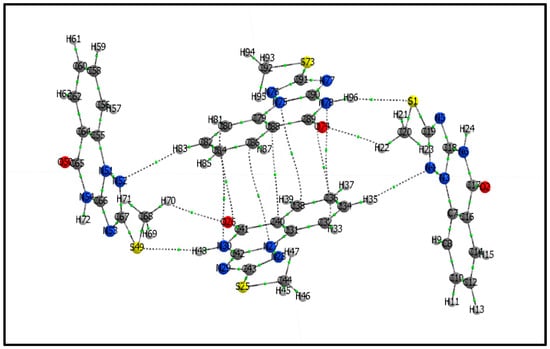
Figure 7.
QTAIM Molecular graphs of dimeric models for compound 1: This figure presents two selected dimeric models from the packing structure of compound 1. The atoms are represented by colored balls, with each color corresponding to a specific element: blue for nitrogen, yellow for sulfur, red for oxygen, the standard element color for carbon, and white for hydrogen. The numbers assigned to the atoms range from 1–24 for the first molecule, 25–48 for the second molecule, 49–62 for the third molecule, and 63–86 for the fourth molecule. These visualizations provide valuable insights into the intermolecular interactions and arrangements within the compound’s packing structure.

Figure 8.
QTAIM Molecular graphs of selected trimeric models for compound 2: This figure displays the chosen trimeric models from the packing structure of compound 2. Atoms are represented by colored balls, with each color corresponding to a specific element: blue for nitrogen, yellow for sulfur, red for oxygen, the standard element color for carbon, and white for hydrogen. The atom numbering ranges from 1–26 for the first molecule, 27–52 for the second molecule, and 53–78 for the third molecule. These color-coded and numbered visualizations provide a clear and comprehensive understanding of the molecular structure and composition of compound 2.
3.7. Evaluation of Non-Covalent Interactions Using a Method Called Reduced Density Gradient Reduction
The identification and visual representation of non-covalent interaction regions were primarily achieved using the NCI-RDG method, which provides a comprehensive analysis of van der waals (VdW) interactions, hydrogen bonds, and steric repulsion in the studied crystals. Figure 9A–D display the 2D scatter plots and 3D color-filled RDG isosurfaces for dimer systems of 1 and 2, respectively (Figure 9A,C). The surfaces are color-coded on a blue-green-red scale based on ρ (r) values, ranging from −0.035 to +0.02 a.u., with an RDG isosurface value of 0.65. As per the NCI method, stronger attractive interactions occur at higher density values (ρ (r) < 0), while repulsive interactions arise at very low density values (ρ (r) > 0). For triazoloquinazoline 1, three spikes in the negative region of ρ (r) (−0.04 to −0.02 a.u.) in the scatter maps suggest the presence of significant attractive interactions within the dimeric model. Low-gradient peaks appearing on the positive side (+0.01 to +0.02 a.u.) indicate the presence of steric effects. Notably, the nature of interactions is more apparent in the 3D graph, where steric effects between aromatic rings are visible due to the red color of the corresponding isosurfaces. Weak hydrogen bonds (closed-shell interactions) N4–H4…N3 and N1–H1…O2 for 1 and 2, respectively, are evident as green cloud isosurfaces. In compound 1, green RDG isosurfaces appear at the center of the three-ring system and between (S1-H96 and H48-S49), while in 2, they are presented between (C46—C74 and C16—H71), indicating very weak VdW interactions. This region corresponds to the spikes at ρ(r) ≈ 0 a.u. in the scatter map. The semi-red color of the latter isosurfaces aligns with the idea that each dihydrogen contact contributes to a ringed shape (Figure 9B,D).
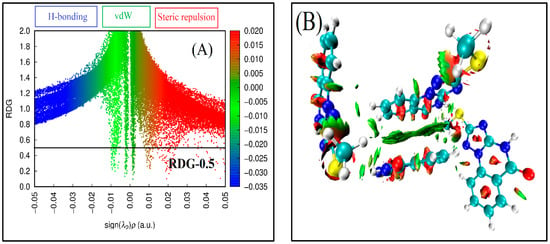
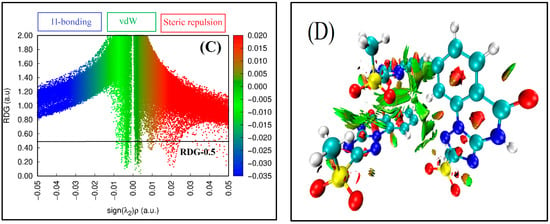
Figure 9.
Demonstrating the NCI index as isosurface maps in (B,D), while (A,C) exhibit the RDG scatter plots for compounds 1 and 2, respectively, all determined using the B3LYP-D3/6-311G theoretical framework. Utilizing an RDG boundary of sign(λ2)ρ = 0.5 a.u. and a color scale extending from −0.035 to 0.02 a.u., attractive, van der waals, and repulsive forces are denoted by blue, green, and red surfaces, respectively.
3.8. Chemical Reactivity Properties: A CDFT Reactivity Indices Analysis
3.8.1. Global Reactivity Indices
Local reactivity is also shown by the vertical ionisation potential (IP) and electron affinity (EA). Compound 2 has higher IP (8.894 eV vs. 7.7485 eV) and EA (0.4702 eV vs. 0.0255 eV), showing that it is more difficult to remove an electron from or add an electron to compound 2 locally. Therefore, 2 is less locally reactive. The electronic chemical potential (μ) measures the electron accepting/donating power of a molecule. Compound 2 has a more negative μ (−4.6821 eV vs. −3.887 eV), indicating it has a greater ability to accept electrons. Thus, 2 has strong electrophilic characteristic. The chemical hardness (η) measures the resistance to change in electron distribution. Triazoloquinazoline 2 has a higher η (8.4238 eV vs. 7.723 eV), indicating it is more “inert” and less polarizable. Therefore, compound 2 is less reactive. The global electrophilicity index (ω) measures the energy lowering due to maximal electron flow between donors and acceptors. Compound 2 has a higher ω (1.3012 eV vs. 0.9782 eV), indicating it is more electrophilic. This is consistent with the more negative μ of 2. The global nucleophilicity index (N) measures the energy gained by maximal electron flow between donors and acceptors. Triazoloquinazoline 1 has a higher N (3.0524 eV vs. 1.8576 eV), indicating it is more nucleophilic. This is consistent with the less negative μ of 1 (Table 7).

Table 7.
The global descriptors of the compound 1 and 2.
3.8.2. Local Reactivity Indices
Based on charges (q(N), q(N+1), and q(N−1), triazoloquinazoline 1 has positive charges around atoms 12, 13, and 20 and negative charges around 15, 19, and 25. Electron densities are depleted around atoms 11, 15, 18, and 19. Atoms 4, 5, 11, 15, and 19 are electrophilic and nucleophilic based on f+ and f- values. Based on f0, atoms 6, 7, and 8 are radicalophilic. On atoms 4, 5, 11, 15, 16, 18, and 19, electrophilic and nucleophilic attack is strongly polarizable. The CDD measurements show accumulations of charge density around atoms 14, 16, and 20 and depletions around atoms 11, 15, 18, and 19 (Table S2). In light to the charges (q(N), q(N+1), and q(N−1)), triazoloquinazolie 2 has positive charges around atoms 6, 7, 8, 9, 10, and 14 and negative charges around 12, 13, 16, 17, 18, and 21. Atoms 3, 12, 15, 18, and 20 have low electron densities. Atoms 3, 12, 15, 18, and 20 are electrophilic and nucleophilic dependent on f+ and f- values. Based on f0, atoms 2, 15, 16, 19, 20, 25, and 26 are radicalophilic. Electrophilic and nucleophilic attack is most polarizable on atoms 3, 12, 15, 16, 17, 18, 19, and 20. CDD data show charge density accumulations around atoms 6, 7, 8, 9, 10, 14, 17, and 19, and depletions around atoms 3, 12, 15, 18, and 20 (Table S2) [26].
3.9. Electrostatic Characteristics of Interactions Examined through Molecular Electrostatic Potential (MESP)
MESP evaluated both substances’ electrostatic properties: Compound 1 has two regions of negative electrostatic potential around the amid group atoms N13 and H14 in the quinazoline ring (Figure 10A). The negative potential suggests these atoms can accept hydrogen bonds. These atoms accept H bonds moderately at −0.04830 a.u. The carbonyl group O19 atom has a positive electrostatic potential of 0.04345 a.u. The O19 can donate H bonds due to its positive potential. These complementary hydrogen bonding sites (acceptor and donor) support H bonding in this compound’s crystal structure and reactivity. Compound 2 has −0.06351 a.u. negative electrostatic potential areas surrounding the amid group’s N12 and H13 atoms (Figure 10B). Due to the stronger negative potential value, these atoms can accept H hydrogen bonds better than in compound 1. Compound 2’s O26 sulfonyl group atom has a positive electrostatic potential area of 0.06814 a.u. O26 can donate H bonds. The chemical structure and reactivity of this molecule favour H bonding [30,31].
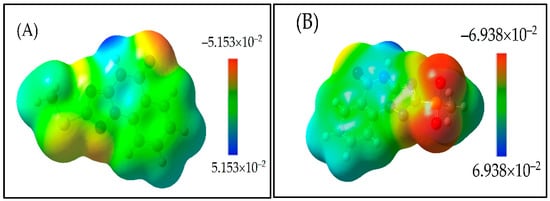
Figure 10.
MESP displays maps for the analyzed triazoloquinazolines 1 (A) and 2 (B) at two distinct sites.
3.10. Antioxidant Reactivity Study
3.10.1. Radicalophilic Study
Based on the results in Table 7, compound 1 show potential for X-centered radical substitution (where X = N, O, polar H and S) and its antioxidant activity due to the several factors as presence of multiple electron scavengers, high P+ values, moderate nucleophilicity, and delocalization of spin density [32,33], whereas in case of 2, the radical scavenging effects are attributed to higher electrophilic P+ values, Lower nucleophilic p-values and Higher f0 values.
3.10.2. Electron Scavenging Activity
The Parr functions of electrophiles (P+) and nucleophiles (P−) will be considered. Parr functions electrophilic indicate an atom’s ability to accept an electron, whereas nucleophilic indicate an atom’s tendency to donate an electron. In the context of N-centered radical substitution, the higher the electrophilic or nucleophilic Parr function, the more likely an atom is to participate in the reaction. For compound 1, the most electrophilic atoms are N12 (348.88 kJ/mol), N18 (430.67 kJ/mol), and S20 (1049.34 kJ/mol). In contrast, the most nucleophilic atoms are C2 (938.72 kJ/mol), C4 (684.78 kJ/mol), and C11 (447.77 kJ/mol). Fukui function (f0), which is an index of the reactivity of a molecule; if f0 is large, then the probability that an atom will take part in the reaction is also large. For compound 1, the atoms with the highest f0 are S20 (389.1 kJ/mol), O19 (227.63 kJ/mol), and C2 (185.1 kJ/mol). Based on this information, the most likely sites for N-centered radical substitution or radicalophilic ability in 1 are N12, N18, and S20, as they have high electrophilic Parr functions. Additionally, the high fukui function values for C2, C3, C4, C11, N18, S20 and O19 suggest that these sites could also be the primary antioxidant sites of 1 (Table 8) [34].

Table 8.
Local electrophilic P+ and nucleophilic P− Parr functions computed with Mulliken atomic spin densities for compounds 1 and 2 (all results in kJ/mol).
In case of compound 2, the most electrophilic atoms are N11 (438.06 kJ/mol), C4 (556.11 kJ/mol), C17 (348.13 kJ/mol), and O15 (388.28 kJ/mol). While, the most nucleophilic atoms are C5 (849.93 kJ/mol), C1 (447.28 kJ/mol), C2 (476.92 kJ/mol), C3 (340.39 kJ/mol), and C14 (342.34 kJ/mol). For compound 2, the atoms with the highest fukui functions are C5 (185.89 kJ/mol), C4 (174.86 kJ/mol), C3 (133.11 kJ/mol), C6 (122.35 kJ/mol), C2 (122.09 kJ/mol), C17 (123.14 kJ/mol), O15 (249.95 kJ/mol), and N19 (103.44 kJ/mol). As a result, the most likely sites for N-centered radical substitution or radicalophilic ability in 2 are N11, C4, C17 and O15, as they have high electrophilic Parr functions. The C2, C3, C4, C5, C6, C17, and O15 (Figure 11), according to fukui functions value, suggested to be the primary antioxidant sites of 2.
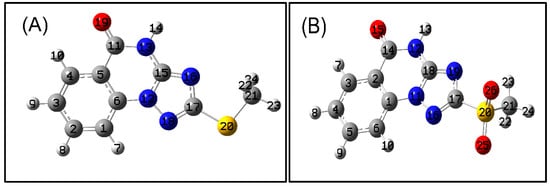
Figure 11.
Ball and stick model of (A) compound 1 and (B) compound 2 visualizing the number of atoms. The ball and stick model provides a 3D representation of the molecular structure where the balls represent atoms and sticks represent chemical bonds. colored balls represent atoms, with each color corresponding to a specific element: blue for nitrogen, yellow for sulfur, red for oxygen, the standard element color for carbon, and white for hydrogen. The numbers assigned to the atoms indicate their positions within the molecular structure.
3.11. Mechanism Actions of the Antioxidants
Compounds that can readily donate hydrogen atoms (e.g., have N-H bonds with low BDE values) will be more radicalophilic, as the transfer of H atoms can quench and stabilize radicals. The BDE values for compounds 1 and 2 suggest the presence of reactive O-H or N-H bonds that may participate in H atom transfer, indicating their radicalophilic ability. Compounds with delocalized electrons or aromatic rings tend to be more radicalophilic, as the delocalized electrons can help stabilize radical species through resonance effects. Compound 1 contains two aromatic rings that may provide resonance stabilization to radicals. While 2 has several double bonds that can delocalize electrons, also suggesting its radicalophilic nature. Compounds with higher antioxidant ability, especially through radical scavenging mechanisms like hydrogen atom transfer (HAT) and single electron transfer-proton transfer (SET-PT), will be more radicalophilic. The results indicate that compounds 1 and 2 both show potent antioxidant activity through these mechanisms, implying their radicalophilic character and this results were agree with previously study [12]. The thermodynamic parameter representing the energy required for the initial step of each antioxidant mechanism (BDE for HAT, IP for SET-PT, and PA for SPLET) is crucial for determining the antioxidant activity of the compounds through that mechanism [26]. HAT mechanism involves only one-step, which is the cleavage of the hydrogen-hydrogen bond. In contrast, the SET-PT which characterized by IP followed by proton transfer (characterized by PDE), and SPLET mechanisms which characterized by PA followed by electron transfer (characterized by ETE).
As presented in Table 9, the BDE values of H8 and H9 (470.52 and 473.75 kJ/mol) are lower than H7 and H10 (482.57 and 480.28 kJ/mol) in 1, indicating that H8 and H9 can be removed more easily. Therefore, H8 and H9 of compound 1 exhibit the highest antioxidant activity through the HAT mechanism. For compound 2, the BDE values of H8 and H9 (474.35 and 472.06 kJ/mol) is lower than H7 and H10 (481.37 and 483.89 kJ/mol), indicating that H8 and H9 can be removed most easily. Therefore, H8 and H9 of compound 2 shows the highest antioxidant activity through the HAT mechanism. Whereas, the PDE values of H8 and H9 (1051.6 and 1054.82 kJ/mol) are lower than H7 and H10 (1063.64 and 1061.36 kJ/mol), indicating that H8 and H9 can transfer protons more easily in compound 1. Therefore, H8 and H9 of compound 1 exhibit the highest antioxidant activity through the SET-PT mechanism. However, the PDE value of H8 and H9 (936.59 and 934.3 kJ/mol) is lower than H7 and H10 (943.61 and 946.13 kJ/mol) in 2, indicating that H8 and H9 can transfer protons most easily. Therefore, H8 and H9 of compound 2 shows the highest antioxidant activity through the SET-PT mechanism. The PA values of H7 and H8 (1609.3 and 1618.94 kJ/mol) are lower than H9 and H10 (1630.51 and 1627.06 kJ/mol) in 1, and the ETE values of H8, H9 and H10 (167.48, 159.14, and 169.12 kJ/mol) are lower than H7 (189.16 kJ/mol). Therefore, H8, H9 and H10 of compound 1 show the highest antioxidant activity through the SPLET mechanism. However, the PA values of H10 (1577.74 kJ/mol) is lower than H7, H8 and H9 (1597.83, 1603.12, and 1594.98 kJ/mol) in 2, and the ETE value of H8 and H9 (187.12 and 192.98 kJ/mol) is lower than H7 and H10 (199.44 and 222.05 kJ/mol). Therefore, H8 and H9 of compound 2 exhibits the highest antioxidant activity through the SPLET mechanism [26,35].

Table 9.
Presents the O–H bond dissociation enthalpy (BDE) values obtained using the B3LYP/6-311G(d,p) method, expressed in kJ/mol.
3.12. Drug-Likeness Properties
Physicochemical properties were calculated for compounds 1 and 2 both demonstrate good drug-likeness and the potential for oral bioavailability. Some key factors that support this conclusion include: molecular weight < 500 Da satisfies Lipinski’s rule of 5 and suggests the compounds can be absorbed by passive diffusion. The 0–5 heteroatoms (nHA, nHD, nHet), both compounds contain 5–8 heteroatoms (N, O), which is a suitable range for most orally bioavailable drugs. The 1–10 rotatable bonds (nRot), compounds 1 and 2 each have only 1 rotatable bond, indicating they have reasonably low flexibility and higher potential for binding to targets. Calculated logP between −0.4 to 5.6, the logP values for both compounds fall within this range, suggesting they have an optimal balance of lipophilicity and hydrophilicity for absorption and distribution. High solubility (logS > −4), the logS values of −3.073 and −3.013 indicate compounds 1 and 2 should have high solubility according to Pfizer’s rule of 5. Compounds obey Lipinski, Pfizer and GSK rules. As we noticed, both compounds satisfy these key criteria for oral drug-likeness, indicating their properties are suitable for pharmacological administration and bioavailability. Few PAINS alerts, No PAINS (Pan-assay interference compounds) alerts were identified, suggesting a low risk of promiscuous activity or false positives. Acceptable QED and drug-likeness scores, the calculated QED, SAscore, and other metrics indicate good potential drug-likeness, especially for compound 2 (Table S3) [35,36].
3.13. The ADMET Properties
The ADMET (absorption, distribution, metabolism, excretion, and toxicity) properties of compounds 1 and 2 can be summarized as follows based on the provided results (Table S3).
Absorption: Caco-2 permeability: compound 1 has a permeability value of −4.754, while compound 2 has a permeability value of −5.933. MDCK Permeability: both compounds have very low permeability values (3.30 × 10−5 and 3.00 × 10−5), suggesting limited absorption. HIA: compound 1 shows positive results, indicating high human intestinal absorption, while 2 shows negative results. Both 1 and 2 do not exhibit P-glycoprotein (Pgp) inhibition or substrate activity. This suggests that they are not likely to interact significantly with the Pgp transporter, which can impact their absorption and distribution in the body [37].
Distribution: PPB (plasma protein binding): compound 1 has a high PPB value of 93.69%, while 2 has a lower value of 67.66%. VD (volume of distribution): Both compounds have similar VD values of 0.482 and 0.488. BBB Penetration: no information is available. Fu (fraction unbound): compound 1 has a low Fu value of 2.29%, while 2 has a higher value of 33.00%.
Metabolism: CYP1A2 inhibitor and substrate: compound 1 is a moderate inhibitor and a strong substrate, whereas 2 is not an inhibitor or a substrate. CYP2C19 inhibitor and substrate: compound 1 shows weak inhibition, whereas 2 demonstrates no activity. CYP2C9 inhibitor and substrate: No activity showed by compound 1, and no information is available for 2. CYP2D6 and CYP3A4 inhibitors and substrates: no information is available for both compounds.
Excretion: CL (clearance): compound 1 has a higher clearance value of 10.412, while 2 has a lower value of 4.545. T1/2 (half-life): both compounds have similar half-life values of 0.804 and 0.818.
Toxicity: hERG Blockers: no information is available. H-HT (human hepatotoxicity): compound 1 shows moderate toxicity, whereas higher toxicity demonstrated by 2. DILI (drug-induced liver injury): both compounds exhibit high DILI toxicity.
4. Conclusions
This theoretical study of triazoloquinazolines 1 and 2 revealed important insights into their molecular structures, reactivity profiles, and antioxidant mechanisms. B3LYP/6-311G(d,p) optimization showed good agreement for 1 geometries but deviations for 2, indicating further refinement is needed. Both compounds exhibit significant intramolecular hydrogen bonding that provides stability, crucial for molecular design. Intermolecular interactions, including hydrogen bonds and π-stacking, also stabilize the crystal structures. Global reactivity indices found 2 more electrophilic and less reactive, and 1 more nucleophilic and reactive. Local indices identified the most electrophilic, nucleophilic and radicalophilic sites, polarizable atoms, and charge distributions. Negative electrostatic potentials showed compounds can act as hydrogen bond acceptors; positive potentials suggest donor ability, consistent with crystal structures. Radicalophilic properties like hydrogen atom donors, resonance and antioxidants suggest radical stabilization may enable antioxidant activity. It was noticed that H7, H8 and H9 in both compounds can exhibit the antioxidant activity via different mechanisms. In compound 1, N12, N18, and S20 are plausible sites for N-centered radical substitution or radicalophilic ability, while in 2, N11, C4, C17, and O15 are more likely candidates. Compound 1 has antioxidant sites at C2, C3, C4, C11, N18, S20, and O19; 2 has antioxidant sites at C2, C3, C4, C5, C6, C17, and O15. Triazoloquinazoline 1 shows better absorption but higher toxicity and environmental toxicity. However, 2 observed poorer absorption but higher toxicity, carcinogenicity, and reduced environmental toxicity. Compound 1 meets Lipinski’s criteria, however, 2 has a larger volume and surface area, indicating poorer permeability; higher solubility and lipophilicity suggest that 1 has better membrane diffusion. DFT research may provide direction for developing 1 and 2 as radical scavenging medication candidates. More theory and experimentation are required to completely identify their antioxidant processes, pharmacological profiles, and clinical prospect.
Supplementary Materials
The following supporting information can be downloaded at: https://www.mdpi.com/article/10.3390/cryst13071086/s1, Figure S1: 2D fingerprints highlighting the percentage contribution of selected predominant intercontacts for compound 1. Figure S2: 2D fingerprints highlighting the percentage contribution of selected predominant intercontacts for compound 2. Figure S3: 2D fingerprints highlighting the percentage contribution of selected predominant intercontacts for compound 2. Table S1: local descriptors of the compound 1; Table S2: local descriptors of the compound 2. Table S3: Drug likeness property of compounds 1 and 2 using ADMETlab 2.0.
Author Contributions
Writing original draft, investigation, and data curation, A.H.B.; writing—reviewing, H.A.A.; writing—reviewing and funding acquisition R.A.-S. All authors have read and agreed to the published version of the manuscript.
Funding
This research was funded by Deputyship for Research and Innovation, Ministry of Education, Saudi Arabia via project no. (IFKSUOR3–347-2).
Data Availability Statement
Not applicable.
Acknowledgments
The authors extend their appreciation to the Deputyship for Research and Innovation, Ministry of Education in Saudi Arabia, for funding this research work through project no. (IFKSUOR3–347-2).
Conflicts of Interest
The authors declare that they have no known competing financial interest or personal relationship that could have appeared to influence the work reported in this paper.
References
- Al-Salahi, R.; Al-Omar, M.A.; Alswaidan, I.; Marzouk, M.; El-Senousy, W.M.; Amr, A.E.-G.E. Antiviral activities of some synthesized methylsulfanyl triazoloquinazoline derivatives. Res. Chem. Intermed. 2015, 41, 151–161. [Google Scholar] [CrossRef]
- Abuelizz, H.A.; Al-Salahi, R. An overview of triazoloquinazolines: Pharmacological significance and recent developments. Bioorg. Chem. 2021, 115, 105263. [Google Scholar] [CrossRef] [PubMed]
- Al-Salahi, R.; El-Tahir, K.-E.; Alswaidan, I.; Lolak, N.; Hamidaddin, M.; Marzouk, M. Biological effects of a new set 1,2,4-triazolo [1,5-a]quinazolines on heart rate and blood pressure. Chem. Cent. J. 2014, 8, 3. [Google Scholar] [CrossRef]
- Al-Salahi, R.; Gamal-Eldeen, A.M.; Alanazi, A.M.; Al-Omar, M.A.; Marzouk, M.A.; Fouda, M.M.G. Cytotoxic and anti-inflammatory active methylsulfanyltriazoloquinazolines. J. Pure Appl. Microbiol. 2013, 7, 189–198. [Google Scholar]
- Al-Salahi, R.; Alswaidan, I.A.; Marzouk, M.S.; El-Eraky, W.; Saleh, D. Antihistamine activity of 1,2,4-triazolo [1,5-a]quinazolines. Asian J. Chem. 2014, 26, 8617–8619. [Google Scholar] [CrossRef]
- Al-Salahi, R.; Marzouk, S.M.; Ghabbour, A.H.; Kun, H.F. Synthesis of Novel 2-(Methylthio)benzo[g][1,2,4]triazolo[1, 5-a] quinazolin-5-(4H)-one and its Derivatives. Lett. Org. Chem. 2014, 11, 759–767. [Google Scholar] [CrossRef]
- Al-Salahi, R.; Geffken, D. Synthesis and reactivity of [1,2,4]triazolo-annelated quinazolines. Molecules 2010, 15, 7016–7034, Erratum in Molecules 2010, 15, 8143. [Google Scholar] [CrossRef]
- Al-Salahi, R.; Al-Omar, M.; Abbas, M.; Ng, S.W. 2-Methylsulfanyl-1,2,4-triazolo [1,5-a]quinazolin-5(4H)-one. Acta Crystallogr. Sect. E Struct. Rep. Online 2012, 6, o1805. [Google Scholar] [CrossRef]
- Al-Salahi, R.; Marzouk, M. Synthesis of novel 2-amino-benzo[de]isoquinolin-1,3-dione derivatives. Asian J. Chem. 2014, 26, 2166–2172. [Google Scholar] [CrossRef]
- Al-Salahi, R.; Marzouk, M.; Abbas, M.; Ng, S.W. 2-Methylsulfonyl-1, 2, 4-triazolo [1, 5-a] quinazolin-5 (4H)-one. Acta Crystallogr. Sect. E Struct. Rep. Online 2012, 68, o1806. [Google Scholar] [CrossRef]
- Al-Salahi, R.A.; Marzouk, M.S. Synthesis of novel 2-phenoxybenzo[g][1,2,4]triazolo [1,5-a]quinazoline and its derivatives starting with diphenyl-N-cyanoimidocarbonate. Russ. J. Gen. Chem. 2016, 86, 1741–1746. [Google Scholar] [CrossRef]
- Al-Salahi, R.; Anouar, E.H.; Marzouk, M.; Taie, H.A.A.; Abuelizz, H.A. Screening and evaluation of antioxidant activity of some 1,2,4-triazolo [1,5-a]quinazoline derivatives. Future Med. Chem. 2018, 10, 379–390. [Google Scholar] [CrossRef] [PubMed]
- Dolomanov, O.V.; Bourhis, L.J.; Gildea, R.J.; Howard, J.A.K.; Puschmann, H. OLEX2: A complete structure solution, refinement and analysis program. J. Appl. Crystallogr. 2009, 42, 339–341. [Google Scholar] [CrossRef]
- Brandenburg, K. DIAMOND; Crystal Impact GbR: Bonn, Germany, 2006. [Google Scholar]
- Frisch, M.J.; Trucks, G.W.; Schlegel, H.B.; Scuseria, G.E.; Robb, M.A.; Cheeseman, J.R.; Scalmani, G.; Barone, V.; Mennucci, B.; Petersson, G.A. Gaussian 09W, Revision A. 02; Gaussian, Inc.: Wallingford, UK, 2016. [Google Scholar]
- Dennington, R.; Keith, T.A.; Millam, J.M. GaussView, Version 6; Semichem Inc.: Shawnee Mission, KS, USA, 2016. [Google Scholar]
- Lee, C.; Yang, W.; Parr, R.G. Development of the Colle-Salvetti correlation-energy formula into a functional of the electron density. Phys. Rev. B 1988, 37, 785–789. [Google Scholar] [CrossRef]
- Jeng-Da, C.; Head-Gordon, M. Long-range corrected hybrid density functionals with damped atom–atom dispersion corrections. Phys. Chem. Chem. Phys. 2008, 10, 6615–6620. [Google Scholar]
- Baur, W.H. Prediction of hydrogen bonds and hydrogen atom positions in crystalline solids. Acta Crystallogr. Sect. B Struct. Crystallogr. Cryst. Chem. 1972, 28, 1456–1465. [Google Scholar] [CrossRef]
- Boys, S.F.; Bernardi, F.J.M.P. The calculation of small molecular interactions by the differences of separate total energies. Some procedures with reduced errors. Mol. Phys. 1970, 19, 553–566. [Google Scholar] [CrossRef]
- Bakheit, A.H.; Al-Salahi, R.; Al-Majed, A.A. Thermodynamic and Computational (DFT) Study of Non-Covalent Interaction Mechanisms of Charge Transfer Complex of Linagliptin with 2,3-Dichloro-5,6-dicyano-1,4-benzoquinone (DDQ) and Chloranilic acid (CHA). Molecules 2022, 27, 6320. [Google Scholar] [CrossRef] [PubMed]
- Bakheit, A.H.; Ghabbour, H.A.; Hussain, H.; Al-Salahi, R.; Ali, E.A.; Mostafa, G.A.E. Synthesis and Computational and X-ray Structure of 2, 3, 5-Triphenyl Tetrazolium, 5-Ethyl-5-phenylbarbituric Acid Salt. Crystals 2022, 12, 1706. [Google Scholar] [CrossRef]
- Humphrey, W.; Dalke, A.; Schulten, K. VMD: Visual molecular dynamics. J. Mol. Graph. 1996, 14, 33–38. [Google Scholar] [CrossRef]
- Jayatilaka, D.; Wolff, S.K.; Grimwood, D.J.; McKinnon, J.J.; Spackman, M.A. CrystalExplorer: A tool for displaying Hirshfeld surfaces and visualising intermolecular interactions in molecular crystals. Acta Crystallogr. Sect. A Found. Crystallogr. 2006, 62, s90. [Google Scholar] [CrossRef]
- Keith, T.A. AIMAll, Version 19.10. 12; TK Gristmill Software: Overland Park, KS, USA, 2019. [Google Scholar]
- Abuelizz, H.A.; Taie, H.A.A.; Bakheit, A.H.; Marzouk, M.; Abdellatif, M.M.; Al-Salahi, R. Biological Evaluation of 4-(1H-triazol-1-yl) benzoic Acid Hybrids as Antioxidant Agents: In Vitro Screening and DFT Study. Appl. Sci. 2021, 11, 11642. [Google Scholar] [CrossRef]
- Ashfaq, M.; Tahir, M.N.; Muhammad, S.; Munawar, K.S.; Ali, A.; Bogdanov, G.; Alarfaji, S.S. Single-crystal investigation, Hirshfeld surface analysis, and DFT study of third-order NLO properties of unsymmetrical acyl thiourea derivatives. ACS Omega 2021, 6, 31211–31225. [Google Scholar] [CrossRef]
- Li, S.; Bu, R.; Gou, R.; Zhang, C. Hirshfeld surface method and its application in energetic crystals. Cryst. Growth Des. 2021, 21, 6619–6634. [Google Scholar] [CrossRef]
- Hajji, M.; Mtiraoui, H.; Amiri, N.; Msaddek, M.; Guerfel, T. Crystallographic and first-principles density functional theory study on the structure, noncovalent interactions, and chemical reactivity of 1, 5-benzodiazepin-2-ones derivatives. Int. J. Quantum Chem. 2019, 119, e26000. [Google Scholar] [CrossRef]
- Abuelizz, H.A.; Bakheit, A.H.; Marzouk, M.; Abdellatif, M.M.; Al-Salahi, R. Reactivity of 4, 5-Dichlorophthalic Anhydride towards Thiosemicarbazide and Amines: Synthesis, Spectroscopic Analysis, and DFT Study. Molecules 2022, 27, 3550. [Google Scholar] [CrossRef] [PubMed]
- Mostafa, G.A.E.; Bakheit, A.H.; Al-Agamy, M.H.; Al-Salahi, R.; Ali, E.A.; Alrabiah, H. Synthesis of 4-Amino-N-[2 (diethylamino) Ethyl] Benzamide Tetraphenylborate Ion-Associate Complex: Characterization, Antibacterial and Computational Study. Molecules 2023, 28, 2256. [Google Scholar] [CrossRef] [PubMed]
- Lardy, S.W.; Luong, K.C.; Schmidt, V.A. Formal Aniline Synthesis from Phenols through Deoxygenative N-Centered Radical Substitution. Chem. Eur. J. 2019, 25, 15267–15271. [Google Scholar] [CrossRef] [PubMed]
- Martínez-Cifuentes, M.; Weiss-López, B.; Araya-Maturana, R. A computational study of structure and reactivity of N-substitued-4-piperidones curcumin analogues and their radical anions. Molecules 2016, 21, 1658. [Google Scholar] [CrossRef]
- Sarkar, A.; Middya, T.R.; Jana, A.D. A QSAR study of radical scavenging antioxidant activity of a series of flavonoids using DFT based quantum chemical descriptors–the importance of group frontier electron density. J. Mol. Model. 2012, 18, 2621–2631. [Google Scholar] [CrossRef]
- Prior, R.L.; Wu, X.; Schaich, K. Standardized methods for the determination of antioxidant capacity and phenolics in foods and dietary supplements. J. Agric. Food Chem. 2005, 53, 4290–4302. [Google Scholar] [CrossRef] [PubMed]
- Eskandrani, R.; Al-Rasheed, L.S.; Ansari, S.A.; Bakheit, A.H.; Almehizia, A.A.; Almutairi, M.; Alkahtani, H.M. Targeting Transcriptional CDKs 7, 8, and 9 with Anilinopyrimidine Derivatives as Anticancer Agents: Design, Synthesis, Biological Evaluation and In Silico Studies. Molecules 2023, 28, 4271. [Google Scholar] [CrossRef] [PubMed]
- Xiong, G.; Wu, Z.; Yi, J.; Fu, L.; Yang, Z.; Hsieh, C.; Yin, M.; Zeng, X.; Wu, C.; Lu, A. ADMETlab 2.0: An integrated online platform for accurate and comprehensive predictions of ADMET properties. Nucleic Acids Res. 2021, 49, W5–W14. [Google Scholar] [CrossRef] [PubMed]
Disclaimer/Publisher’s Note: The statements, opinions and data contained in all publications are solely those of the individual author(s) and contributor(s) and not of MDPI and/or the editor(s). MDPI and/or the editor(s) disclaim responsibility for any injury to people or property resulting from any ideas, methods, instructions or products referred to in the content. |
© 2023 by the authors. Licensee MDPI, Basel, Switzerland. This article is an open access article distributed under the terms and conditions of the Creative Commons Attribution (CC BY) license (https://creativecommons.org/licenses/by/4.0/).